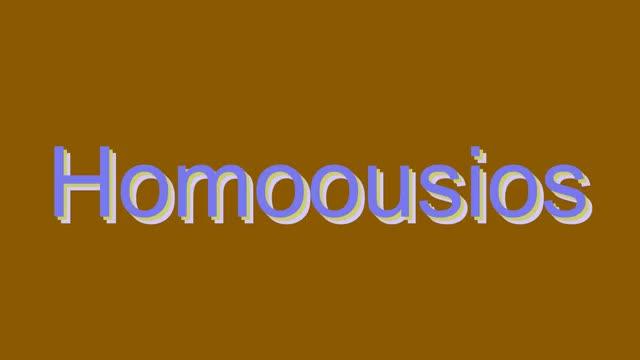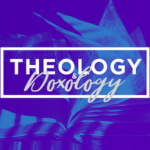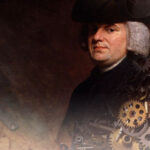
Christology: When an Iota of Difference Really Matters
Sometimes seemingly small things can have big consequences – at least in the world of theology. The smallest of details can at times result in the largest of outcomes. Students of theology and church history will be aware of various examples of this.
Consider one of the more famous cases: the debate over homoousios versus homoiousios. Over what? This is an old Christological debate concerning which Greek word best captures the biblical data concerning Christ and his relation to God the Father.
The debate itself is very complex and detailed, and a brief article like this can barely do it justice. But it is a core part of Christian belief, so all believers must seek to get a handle on this, if even a very brief and introductory handle. So let me seek to elaborate on this pair of words.

You have to look closely at the two Greek words to see just what the difference is: one has an extra “i” (the Greek letter, iota). The first term is the orthodox word used by the early church fathers while the second term was used by those who denied the deity of Christ and the Triune understanding of the Godhead.
The Council of Nicaea of 325 was assembled to deal with these matters. It was part of ongoing discussions as the church sought to iron out what exactly it believed concerning the nature of Christ. Contrary voices to the biblical position were making the rounds, such as that of Arias. He denied the full deity of Christ and insisted that he was merely a created being.
So various terms were used to help elucidate and clarify what the biblical data was saying. One term had to do with “substance”. The Greek word for this was ousia. The Latin word was substantia. As to the Greek version, here is how the two Greek terms in question break down:
homo = the same
homoi = similar to
ousia = substance
When we apply the two different prefixes we come up with two quite different concepts:
homoousios = of the same substance, of the same essence. Thus Christ is equal to the Father in divinity. Christ is identical to the Father. This was the orthodox position being affirmed at Nicea.
homoiousios = of a similar substance, of a similar essence. Thus Christ is not fully equal to the Father in divinity. Christ is similar to the Father. This was the heterodox position being refuted at Nicea.
These debates had been going on before Nicea, but as things came to a head, it was deemed to be necessary to more fully clarify and affirm the biblical teachings on this. The Greek words were especially used in the Council of Nicaea of 325. The Council was convened by Emperor Constantine for the purpose of getting all the bishops in the empire to sit down and agree to a uniform set of beliefs.
There was a mixture of motivations for calling this meeting. Combatting Arianism was the major theological reason of course. But political concerns had also arisen. The bishops exerted a lot of influence and power, and their fighting over this matter was causing a lot of division within his empire, and he wanted to put a stop to it.
There were around 300 bishops present at this council (although others were invited). To put things simply, at the time, the church was divided into two main camps, one believing that Christ was God, and the other believing that Christ was a human being like the rest of us.
Leading the charge for the former was Alexander, Bishop of Alexandria, and then his successor Athanasius. After a fair amount of discussion and debate, the Nicene Creed was produced by this first ecumenical council. The bishops agreed that there could be no half-way house when it comes to the deity of Christ. He could not be partly divine or almost divine. He was fully divine, while also being fully human. The Creed begins this way:
We believe in one God the Father Almighty, Maker of heaven and earth, and of all things visible and invisible.
And in one Lord Jesus Christ, the only-begotten Son of God, begotten of the Father before all worlds, God of God, Light of Light, Very God of Very God, begotten, not made, being of one substance (homoousious) with the Father by whom all things were made; who for us men, and for our salvation, came down from heaven, and was incarnate by the Holy Spirit of the Virgin Mary, and was made man, and was crucified also for us under Pontius Pilate.
Again, the word homoousios means “same substance”, whereas the word homoiousios means “similar substance”. The council affirmed that the three persons of the Godhead – Father, Son, and Holy Spirit – are of the homoousios (of the same substance). The Arians had denied this.
In addition to affirming the biblical stance on this, the council condemned Arius and had him exiled. In his excellent The Word Became Flesh Millard Erickson offers some helpful discussion of the Creed:


It is easier to identify from this statement what is being denied than what is being affirmed. Yet, in so many statements of this type, the list of denials or anathemas is extremely helpful in determining exactly what is being affirmed. We can summarize the Arian tenets that are being explicitly denied in the Nicene Creed:
1. There was a time when the Son did not exist.
2. The Father pre-existed the Son.
3. The hypostasis or substance of the Son differs from that of the Father.
4. The Son is a creature similar in every way to the other creatures.
5. The Son is subject to alteration and moral change.
These denials are in turn denials of two underlying assumptions of the Arians:
1. The Father-Son relationship is literally the same as that between earthly fathers and son.
2. The birth of Jesus should be equated with his origin or the beginning of his existence.
But positive elements are found in the Creed. And it was so very important that these church leaders took a stand at this critical period. As Donald Macleod in his The Person of Christ puts it:
In their judgment, the future of Christianity as a religion was at stake. If Christ were not God, he could not be the revelation of God. If Christ were not God, men had not been redeemed by God. If Christ were not God, believers were not united to God. Above all, if Christ were not God, Christians had no right to worship him. Indeed, if they did so, they were reverting to pagan superstition and idolatry….
There can be no doubt that Athanasius and his colleagues were correct in their perception that Arianism threatened Christianity at its very heart. If Christ were a creature, no matter how exalted, or even a kind of inferior deity (god, but less than Absolute God) worship of him would be entirely illegitimate. This is why the term homoousios (‘the same in essence’), incorporated by the Council in its final communique, was so important. It safeguarded not merely a theological dogma but the very core of the piety and worship of the church.
Of course the debate did not end there. Arianism resurfaced, and Athanasius and others had to keep battling it. Athanasius endured five periods of exile as he stood strong on the orthodox position, refuting Arianism. Stephen Nichols picks up the story:
“Just after Athanasius’s death in 373, Theodotius I convened a council at Constantinople in 381. Athanasius’s decades of championing the cause for orthodoxy came to fruition as the Nicene Creed from 325 was reaffirmed and firmly planted in the church.”
Thus we refer to this as the Niceno-Constantinopolitan Creed. The debates did not end there however. While Athanasius helped to firmly establish the full deity and full humanity of Christ, it remained to be worked out how these two natures in one person cohered. That was carefully dealt with at the Council in Chalcedon in 451. I cite Nichols again:
These two creeds, the Nicene Creed (325, 381) and the Chalcedonian Creed (451), form the basis of orthodox christology, informing us that Christ is fully God and fully human, and that those two natures conjoin perfectly and fully in one person. These councils and their creeds did not put an end to christological controversies, however. Such controversies continue to this day. But they do represent the boundaries for the church in her expression of the person of Christ, and they do confront the potential challenges to a biblically faithful christology. Views of Christ err when they deny or limit the humanity of Christ, deny or limit the deity of Christ, or confuse how the two natures come together. Since all christological heresies trace back to one (or more) of these three errors, Nicaea and Chalcedon provide the boundaries to keep us from such errors.
This far too brief overview of the Nicene controversy hopefully will help at least somewhat in laying out what very important matters these were back then – and still are. Those who have little time for theology may scoff, and critics can poke fun at all this.
As but one example, in his The Rise and Fall of the Roman Empire, the eighteenth-century historian Edward Gibbon mockingly observed that the Church was divided over a single iota: it was a mere “iota of difference”. But in this case a small detail had huge ramifications.
That one little letter meant all the difference between Christian orthodoxy and heretical heterodoxy. Had it not been defended so vigorously back then, we might all be Arians now – or worse. In conclusion, Alister McGrath puts in this way:
In Jesus, we encounter God at first hand, directly. To encounter the risen Christ is to encounter none other than the living and loving God. To put this in a dangerously crude way: God knows what it is like to be human. Although only a single letter separates homoiousios (“being like God”) from homoousios (“being the same as God”), a world separates the views of Jesus which they represent. In English, the difference might be brought out by saying the former corresponds to “Jesus is good” and the latter to “Jesus is God.” They differ only by a letter, and yet by everything.
For further reading, see this article for a list of some 120 titles on Christology: https://billmuehlenberg.com/2017/12/16/christology-select-bibliography/
[1743 words]




















Thanks, Bill. I commented yesterday about this “letter of difference” but had said it was an omicron rather than an iota, and referenced the schism between the Eastern and Western Church. My years away from the discussion became quickly obvious. This little refresher has placed me back in the right spot. One can never review enough, and your present challenge of taking us into the deeper waters of theology is well worth it. Keep up the good work.
Dear Bill
It may be helpful to note that the 2010 edition of the Roman Missal renders that part of the creed “consubstantial with the Father” which is clearer than the Anglican attempt “of one being with the Father”. Our Lord’s nature goes to the argument to do with His validity as a mediator and saviour
Dear Bill
Thank you so much for this article it has clarified a lot for me. Our pastor recently resigned from our mainline church as he now no longer believes in the orthodox view of the Trinity. I now understand where he is coming from. I despair at the liberal theology which tells me that all I have to do is “be Jesus”, that “theology is not for today” and that love is all that counts. I have always believed that the foundation of our belief is our theology but it appears from the subsequent reactions in our church that I am in the minority. Again, so thankful for this article, for this website and for your work.
Margaret
Many thanks Margaret.
Very true but how many in the Anglican churches these days, for example, claim that Jesus never said anything about homosexuality. To do that you either have to claim that God was misquoted in the Old Testament and so deny the scriptures, or deny that Jesus and the Father are one, which is denying the very fundamentals of Christianity. I constantly come across people who claim to be Christian yet claim that Jesus and the Father say different things, which clearly is a denial of very, very fundamental Christianity. Surely this has to be a significant indication of the pseudochristos Jesus warned us about and demonstrates clearly that claimed Christians are just as capable of worshiping God in vain, by teaching their own commandments, as were the Jews. (Mat 15:9)
Hi Bill
On a somewhat lighter and less academic or theological note, the difference between the ‘Word’ and the ‘world’ is an “L” – but it’s one “L” of a difference!
Yes quite so Roger!